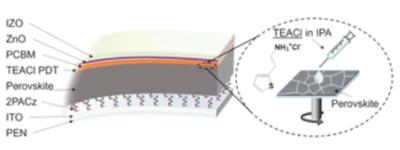Researchers from Empa, EPFL, Sichuan University, Jiaxing University, Soochow University, University of Cologne, University of Potsdam, HZB and the University of Oxford have developed a flexible all-perovskite tandem solar cell with a mitigated open-circuit voltage deficit and reduced voltage loss. The team reported flexible tandem efficiency of almost 24% on small area cells using the spin coating method.
Flexible all-perovskite tandem cells are currently less developed than rigid cells, due to a difficult deposition process for the cell's functional layers and a lower open-circuit voltage. This is due to high defect densities within the perovskite absorber layer and at the perovskite/charge selective layer interface.
“Over the past years, many approaches, including compositional engineering, additive engineering, interfacial engineering, and mixed-dimensional engineering, have been explored and the open-circuit voltage deficit has been reduced to values as low as 0.37 V in perovskite solar cells with bandgap of around 1.72 eV suitable for perovskite-Si tandems,” the researchers explained. “However, extending these strategies to mitigate the open-circuit voltage deficit in perovskites with even wider bandgaps of around 1.80 eV that are required for two-terminal (2T) all-perovskite tandems remains very challenging.”
For the device subcell, the scientists replaced the conventional hole transport layer (HTL), which is made of poly-triarylamine (PTAA), with another made with a self-assembled monolayer based on the 2PACz carbazole additive. They also passivated the perovskite layer through a postdeposition treatment (PDT) with 2-thiopheneethylammonium chloride (TEACl) and used an electron acceptor made of phenyl-C61-butyric acid methyl ester (PCBM).
They embedded the resulting perovskite subcell in a flexible two-terminal (2T) all-perovskite tandem device, which achieved a power conversion efficiency of 23.8%, a high open-circuit voltage of 2.1 V, a short-circuit current density of 15.1 mA cm−2, and a fill factor of 75.1%.
“Notably, the open-circuit voltage of 2.1 V of our flexible 2T tandem solar cell is higher than the open-circuit voltage of the best performing rigid tandem (2.03 V) and flexible (2.0 V) tandem devices reported to date,” the scientists said.
“Our next step is to replace all the spin-coated steps with an industrial scalable and cost-effective slot-die coating method and demonstrate flexible all-perovskite tandem modules with comparable efficiency as demonstrated in small area cells,” Empa's Fan Fu said. “Commercial production will be considered once high efficient flexible tandem mini-module could be demonstrated using industrially scalable methods.”
